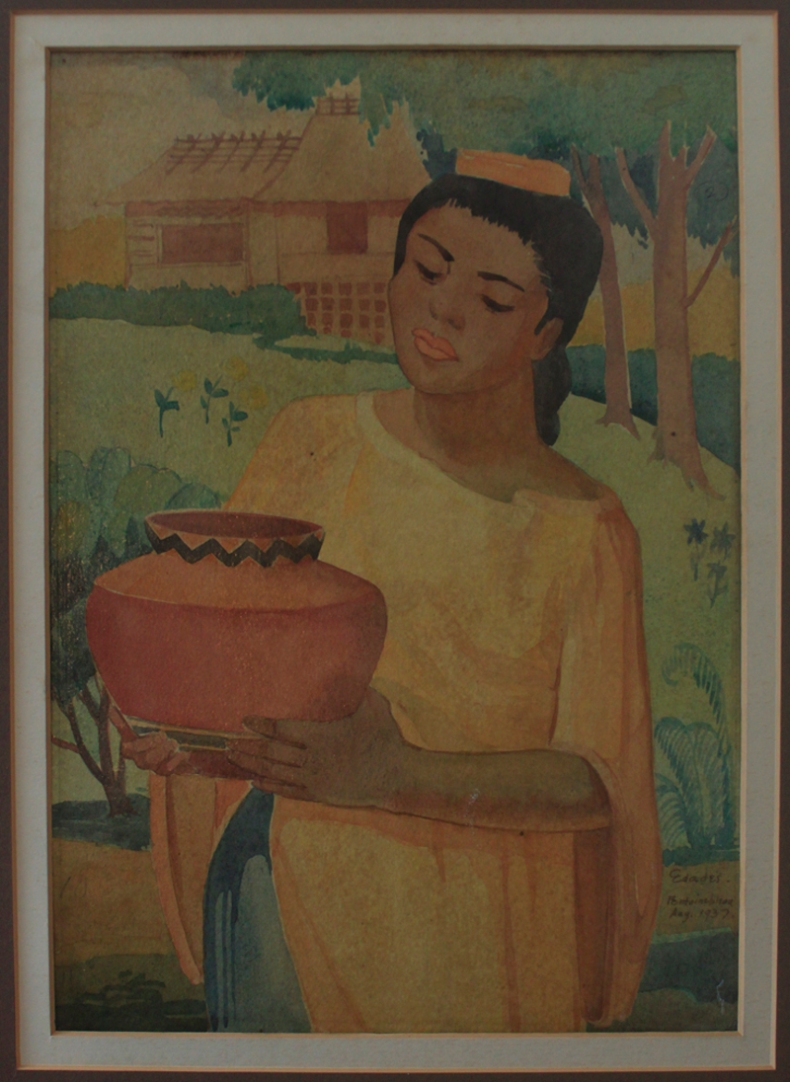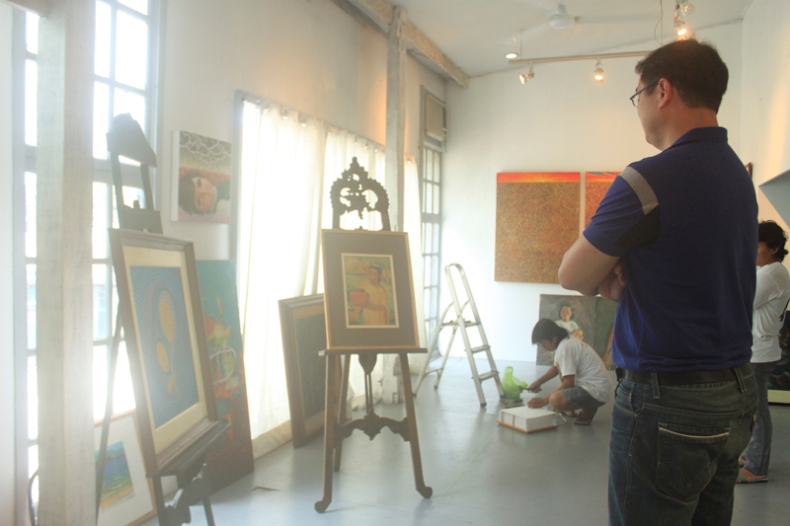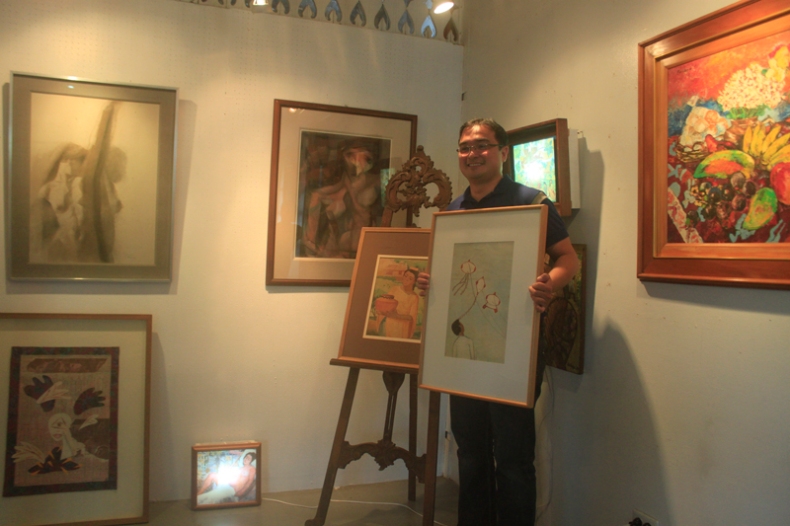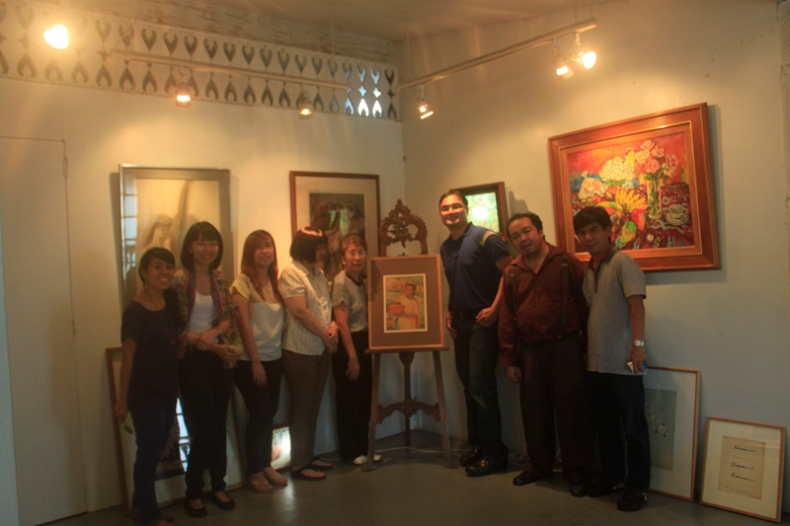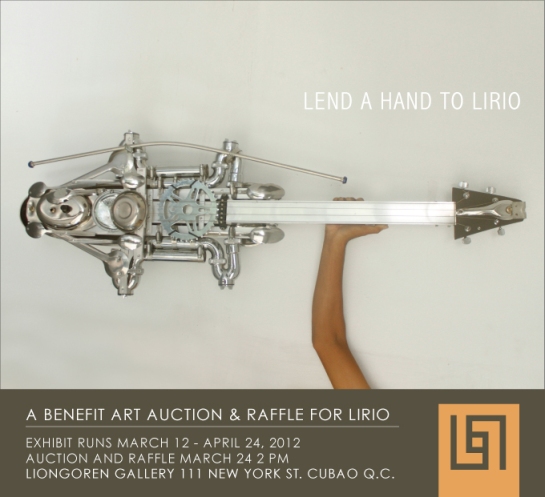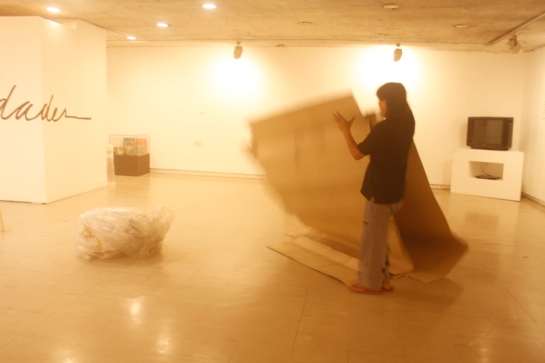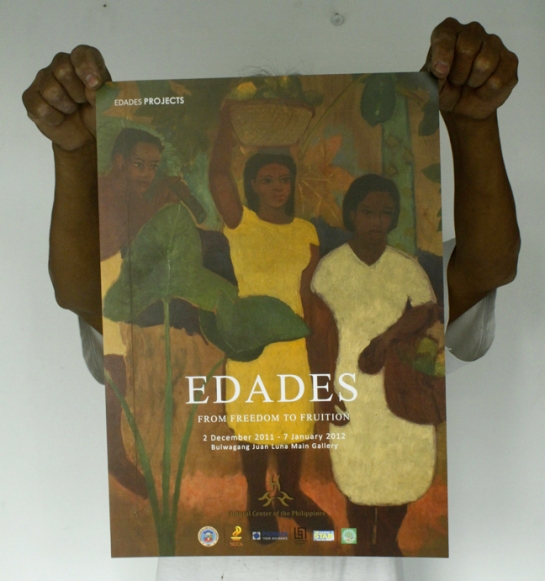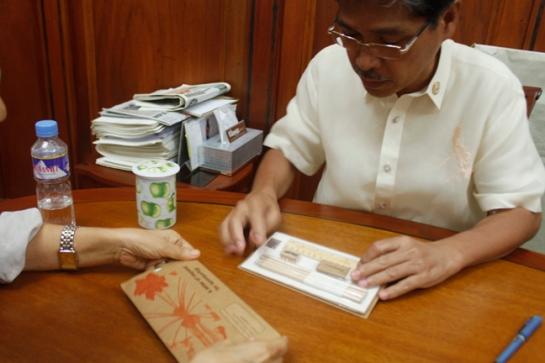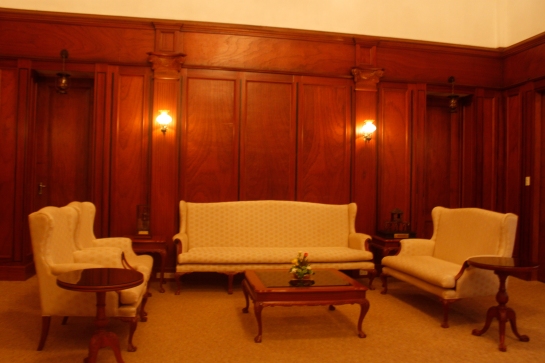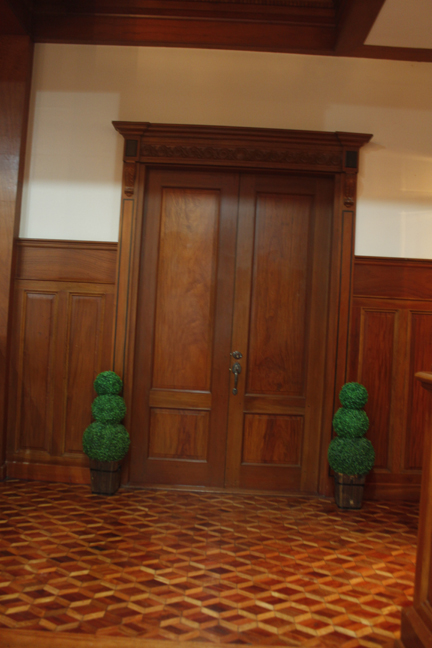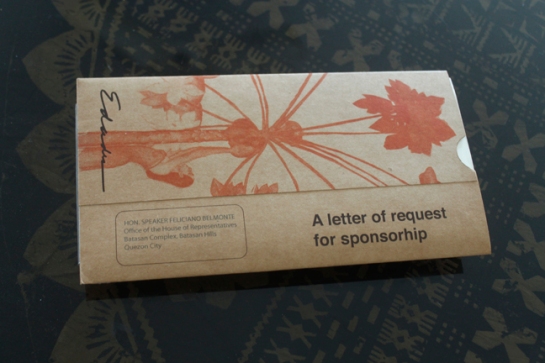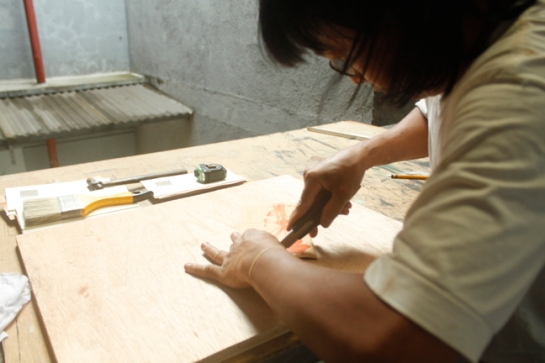The biggest find of the Edades Projects’ “Urban Archaeology”
By ROMMEL EARL DIGO, Project Coordinator, the Edades Projects

“Today, there are progressive filipino architects and painters who remain true to their inner vision in spite of ridicule and general indifference. with the reforming zeal of priests or saints these artists are forcing to the forefront the issue of vitalizing the Philippine art world.”
-Towards Virility in Art, This Week, 1948

June 9, 1975
Dear Belen,
I hope this book, “THE ART OF INTERIOR DESIGN”, will help you in your advanced Classes in Interior Design. If by any chance you already have a copy of this good book, you may pass it to whoever you want to.
Uncle Vic.
P.S. I used this book as one of my references when I taught Art Appreciation of all arts.
Uncle Vic
September 8, 1976
Dear Belen,
“The other day, I read at the at the Architectscope that our architectural students composing a group of three won a top prize in the intercollegiate composition among the universities in the world.
“And one of our alumnus, Leandro Locsin has created another sensational masterpiece, the International Convention Complex, a part of the Cultural Center Complex at the Roxas Boulevard.”
So goes excerpts of many correspondences of National Artist Victorio Edades stretching from his famous magazine articles in 1948 to his personal correspondences to Interior Designer Belen Morey, (one of the select few whom he personally picked to become part of the faculty of the UST College of Architecture and Fine Arts- in 1976. The National Artist award is a national award of recognition given to Filipinos who have made distinct contributions to arts and letters, and a Man of letters Edades was, as the volume of correspondences would attest.
Who would have known that Interior Design and Architecture were also among the academic advocacies of Edades, who is known as a painter?
With an unerring sense of mission, Victorio Edades’ life work as an educator and administrator in the university of Santo Tomas , coupled with his modernist crusade as a painter and academe opened the way to new artistic idioms, as well as broadened the subject of art to translate seamlessly into other academic and professional disciplines that span the entire range of human experience.
As a kid I grew up reading about the country’s prominent interior designers, architects and artists. I still have a copy of a Readers Digest supplement section from 1971 featuring a work of Wili Fernandez, which has :
“An antique pulley lamp, an oil painting , a Chabet collage and black and white throw pillow complete the room’s air of eclecticism…”, aside from the works of Johnny Hubilla, Edgar Ramirez and Ched Berenguer Topacio. We all grew up with the modernist silhouettes of Carlos Arguelles” Philamlife Building, Jose Maria Zaragoza’s Meralco Building, Locsin’s CCP and PICC, and Manosa’s Coconut Palace ( which allude’s to Edades’ search for our national identity)as backdrops to our lives, yet these buildings and more are five testaments for the ages about Edades legacies thru these UST graduates.
I did mention Chabet, another alumnus, who during that era was instrumental in the CCP’s purchase of Edades’ landmark work for his 1928 iColumbia Club exhibition, “The Builders”.
I finally met Edades’ fellow faculty and students Edades’ when I was a staff writer for a cultural magazine during the 1990s.
In between editorial deadlines I got to know them thru interviews,
for articles ,which thru the years graduated into monographs and coffe table books, even event management for some silent auctions, the first one of which I could still remember a copy of of Purita Kalaw Ledesma’s “Edades: National Artist” among other items up for bid ina silent auction.
It is in that book that I first saw a glimpse of Edades’ Tree of Art.
It’s been two decades of having collaborated or crossed paths with many UST graduates who eventually found their biographies athe CCP Encyclopedia :Architect Leandro Locsin, Madam Purita Kalaw Ledesma, Interior Designer Edgar Ramirez and his restoration of the National Museum’s Hall of the Masters,Architect Francisco “Pandot” Ocampo (who along with Edades, was one of the pioneer faculty of the UST in 1930), Dalena, Orlina, Magsaysay Ho, Architect Jose Maria Zaragoza thru his masterpiece the Meralco building in Ortigas, Architect Juan Arellano thru editing an article on the Metropolitan Museum of Art, Cesar Legaspi , H.r. Ocampo thru various collectors, Interior Designers Berenguer Topacio and her furniture which has been advertised worldwide,and Hubilla, Architect Manosa, Lazaro Soriano, Olmedo, Baldemor, Jerry Navarro, Interior Designer Wili Fernandez thru an article by another UST Graduate Rodrigo Perez III, Architect Juan Nakpil thru his iconic Quiapo Church Some names might not be familiar, but the works of these UST alumni are monuments to Edades’ legacy as an academe.
Hollywood in the 1930s used to boast that MGM had more stars than the heavens but it seems the UST has more, and those years were not yet the zeitgeist of Ronald Ventura.
Little did I know that a deeper understanding and appreciation of the collective body of work of Edades’ fellow teachers and students have already gelled in me.
The magazine also featured the works of other senior and younger students of UST: Edong Lazatin (who’s residence has been featured by CNN’s Elsa Klensch in th early 1990s),Manny Castro, Roland Laurena, J. Antonio Mendoza and Reimon Gutierrez. It was the mid 1990s. The world was not quite as digital then, beepers were still being replaced by a new gadget called the cellphone, and coffeetablebooks with colored pictorials were more exclusive in terms of subject matter untiltechnology and mass culture had caught up with it.
LEGENDARY SISTERS
It was 1996 and I was covering the Asia Pacific International Trade Fair for a cultural magazine. The guests of the evening were the editors of such prestigious publications as Elle Decoration, Metropolitan Home, House Beautiful,Conde Nast House and Garden, Marie Claire Maison, name it. The hosts of the evening were the Philippines ’ foremost interior designers and the occasion was the dinner to cap off the 1996. That’s where I first met the interior designers Ched Berenguer Topacio and Belen Morey. I was to meet both women in various public events from the mid to the late 1990s: a couple of silent auctions and most especially when both along with Ms Morey’s sister Leti Limpo were among those conferred to the college of Fellows at the Philippine Institute of Interior Designers’ 34th Anniversary in 1998.
I can still recall how the host of the evening, Gerry Contreras, described the siblings as “the legendary Sablan sisters” a description which only during the duration of the Edades Projects did I finally rediscover.
I remember editing the monograph “LEANDRO V. LOCSIN – THE POET OF SPACE” published by the Cultural Center of the Philippines in 1997. The articles included “RENAISSANCE MAN” by Rodrigo Perez III, who graduated from the Santo Tomas School of Architecture in 1953, where he was a classmate of Leandro V Locsin .
“After two years of liberal arts and music with only a year to earn a bachelor’s degree in music, he decided to shift to architecture. It meant starting again as a freshman, but that didn’t matter.
He was not aware of it then, but his decision was timely, for the UST School of Architecture was beefing up its faculty by bringing in such distinguished practitioners as Angel Nakpil , a graduate of Harvard University, and Carlos Arguelles, a graduate of the Massachussetts Institute of Technology.”
I had no idea back then about the person who was behind the beefing up of the faculty.
In 1999 I was able to collaborate with Leo Almeria for the coffeetablebook “At Home with Filipino Art and Artists”,in a pictorial of the heirloom chairs handed down from Dona Rosario Luz (another legendary interior designer from the mid 20thcentury) in the residence of her National Artist son.
Fast forward to 2009. It took no less than a statement from interior designer LEO ALMERIA “Nobody among the interior designers would have even started if they did not go under EDADES” he told gallery owner Norma Liongoren. Thus, what was conceived as a continuing initiative that “seeks to explore and learn from the different facets of the life- works of the late National Artist Victorio C. Edades (1895-1985), the Father of Modern Art in the Philippines ”, was given a jumpstart. Thus the Edades Projects was reborn.
The genesis of the Edades Projects started in 1972, when the Projects’ Head Norma Liongoren, together with husband painter Fred sought him out in Davao City where he resided upon retirement from UST College of Fine Arts and Architecture, the college he founded. Being of kindred spirits they were welcomed warmly in the Edades home.
.
Just like Edades Norma Liongoren is a fellow Dagupeno and now a Davaono,having just moved to the city of Durian and Waling-Waling. Later upon resettling in Manila , Norma Liongoren was able to convince the now Davao based artist to exhibit again in Manila in 1976 after a long hiatus. The year 1976 was the same year Edades was bestowed the National Artist Award, the third to be honored in Visual Arts, after Amorsolo (1972) and Botong Francisco (1973). In 2010 , Norma Liongoren was invited by Rockwell Land to be their consultant in creating an art event related to the National Artist after whom they have named their next high-rise condominium, the Edades Tower and Garden Villas at the Rockwell Center . She recruited me and the noted interior designer and educator Mary Ann Venturina Bulanadi, who has made substantial research on the pioneering faculty of the University of the Philippines College of Architecture and Fine Arts in this endeavor. The exhibit did not quite push through as planned but we , who stayed on as a core team, decided to push through with holding a major retrospective somewhere else. One day in 2011, while we were touring the grandly formal, high ceilinged room being renovated at the National Museum, a plan to relaunch a 1931 party held at the Edadeses’ prewar San Juan home was suggested .Little did we know that the excavation-like backdrop of the renovation of one Manila’s biggest remaining prewar edifices..what with the original stonework
finally revealed in the otherwise gutted down interiors.. would set the tone for what was to become an adventure: a crash course in “urban archaeology” : the Edades Projects will not be just about paintings… it will be about discovering literally heaps of priceless ephemera produced by the artist himself , hidden for decades in various private addresses from Luzon to Mindanao, all just waiting to be exhibited for the very first time.
Thus with the help of the staff of the National Museum, the Edades Tea Party was held in July 29 at the prewar Addition Hills residence of the National Artist.
From the outside, the Addition Hills house of the Edadeses looks just like the handful remaining 1920s houses which dot the metropolis , but continuous repartee with the current resident, Clarita Pagulong, revealed more and more of its provenance: “the original house was built by P.D. Carman.” It might just be the only remaining house built by P.D. Carman, the once socially prominent prolific but now forgotten real estate mogul of 1920s Manila , which still exists. But through the decades, the original house has been eclipsed by by a bigger house which annexes it, designed and built by no less than Edades himself. In building the house , Edades put to practice what he has always learned during his days as an archicture student in the United States, yet he has added to his design his use of indigenous materials such as capiz windows, coconut trunks for posts and sawali for the walls of his studio.These are still intact and can be seen today.The original photographs in the book “EDADES” National Artist” by Purita kalaw Ledesma showing a 30 something Edades Painting in his studio belies this.
We had to refer to page 81 of another book, “Edades” Kites and Visions” by Lydia Rivera Ingle for the names of some of the pioneer faculty whom he personally selected who might still be with us:
”The enrolment in both architecture and painting was exceptionally large. The demand for the opening of two other branches offine arts,namely, interior design and advertising arts was persistent. I believe in the adage “the faculty isd the university”. For this reason ,and in order too maintain the high standard which wanted the college to follow, i hired the best available professors. I hired Carlos Francisco and Vicente Manansala for painting, Berenguer Topacio and Cora Chioco and Belen Morey for interior design, and Jerry and his wife Virginia navarro, and Manuel Rodriguez sr for advertising.”
He was quoted that statement in 1966, the year of his retirement from UST.
So we found ourselves looking at the lists of the various cultural institutions, museums and collectors names at the back pages of that book along with other books and brochures on Edades, and tracking the whereabouts of all those names took about half, maybe even an entire year.
But two names in the list of collectors at the back of the book by Lydia Rivera Ingle simply popped before my eyes: Leticia Limpo and Belen Morey.
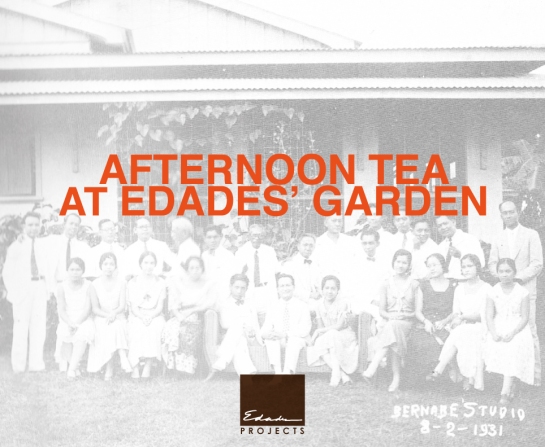
Both women (who, as we were to acome across during in one of the city’s cultural libraries, were, along with Ched Berenguer Topacio, featured in a cover story on the then new profession of Interior Design for the Sunday Times Magazine back in 1956) helped organize the Department of Interior Design at the UST College of Architecture and, along with Mercedes Berenguer-Topacio, made their alma mater a premier school for artists and designers in the country.
THE INVITE THAT OVERDID ITS JOB
The invite was effective..in fact maybe it was a bit too effective.

So went the contents of the invite which showed a large group picture of Edades’ guests in 1931, including Fernando Amorsolo, Nena Saguil, Consuelo Lee and most especially Fabian de la Rosa, who a year earlier, as Director of the up College of Fine Arts, politely declined his application to become member of the faculty.
On August 2, 1931, Mr and Mrs Edades entertained the faculty members of th eUP School of Fine Arts. The party, held in the Edades bungalow in San Juan … was a sendoff for Candido Alcantarai selected as a government pensionado (grantee) to study theater arts in Europe.
It certainly created all kinds of responses: a senior interior designer who was in the UNITED States when she was sent the invite, asked me upon her arrival months later, how she could get in touch with the national artist but I responded with a humorous “he’s dead…since 1985”, much to her surprise. It so happened that upon receiving the invite for the Tea Party, th einteiro designer informed her contemporaries in UST who are now in the United States and they immediately wanted to come back to the Philippines with her just to see the legendary artist.


The ever dapper interior designer Johnny Hubilla, who was also a UST student during the tail end of Edades’ tenure at the University, also happened to be one of the movers and shakers behind the 400thanniversary of the university, and he willingly gave suggestions as to who else to contact.Thus about a dozen of his former students and colleagues,even a former model/student (in the person of Interior Designer Ching Belleza, the sister of actress Barbara Perez) converged and took stock of the academic legacy of their teacher. They all came sporadically but each and everyone gave off an enormous focused energy and a radiance when asked to recall their treasured memories of the National Artist, who at sometime during their stay in the UST was their teacher.
The recollections of the graduates touched all bases, even edades’ quest for new teachers immediately after the war:
“AMONG THE FACULTY THERE WAS CARLOS ARGUELLES FOR ARCHITECTURE, JERRY NAVARRO FOR ADVERTISING… THERE WAS PRACTICALLY NOBODY ELSE AVAILABLE WHO COULD BE INVITED TO TEACH IN THOSE TIMES” – LETI LIMPO
To the fate of his Manila paintings when he decided to retire from UST and move to Mindanao :
“Prior to his departure for davao he left all of his paintings in my house here in makati which virtually became a gallery.”- BELEN MOREY
But it was world famous interior designer Ched Berenguer Topacio, who’s works have graced the pages of glossy international publications(one of which is in an issue of Conde Nast’s Architectural Digest ) who shared a dramatic, sepia colored account of how Edades selected the teachers:
“I STUDIED ARCHITECTURE IN UST WHEN ROCHA WAS THE DEAN. WE HAD TO attend classes in makeshift quoinset huts that the americans built during the war.
“After graduating, i went to the united states where I studied at the New York School of Interior Design. Soon after, Paquito “Pacquing” Aguinaldo also went to the United States to fetch me back. He asked ‘why are you wasting your time here in the states. Come, we will build a first in the Philippines, a new department store for furnishings, featuring designs that are all filipino made (breaking the prewar tradition of furniture stores with designs copied from american magazines.) Thus he encouraged me to go back with him to Manila .
“So just when i was starting to help the Aguinaldos in putting up their department store, i received a call. It was Victorio Edades.
‘Take a visit to the UST… Just take a visit.’ Edades said on the phone.
“So I did visit, so after being toured around the then new postwar constructions of the campus,Edades finally brought down the point: “I am putting up another first in the Philippines a new interior design program , and i want you to to teach in it.”
“Given my commitment to Pacquingf Aguinaldo, I thought really hard about making a decision… so Edades added “You owe it to your alma mater.”
And little did our team know that from this point, that our first windfall of sorts would come from an unexpected source, not from the visual artists, as Norma Liongoren , who has known many of Edades’ patrons even longer than the three decades of continuing existence of her gallery, but from the interior designers, led by Ms Morey.
The correspondences of Edades to Belen Morey from 1970 to 1977 is a real pot of GOLD a treasure trove of personal letters and correspondences from Edades, with some very revealing facets on his knowledge of himself no less:
“ These lectures of mine, my published articles conservative opponents – sculptor tolentino, prof. Estrada ofdelasale college and art critic manlapaz and my revolutionary paintings have earned for me “the father of modern art in the Philippines .” Letter to Belen Morey january 2 1976
Edades was as much a staunch teacher of the interdisciplinary artists as he was an avid advocateof the latest trends in interiors, as in this letter wherein he discusses furniture made of indigenous materials:
The rattan furniture is getting to be a fad in U.S.A. because rattan is light to move around and besides, Americans like to appear living in the hot tropical country like thePhilippines…Now, among the well to do Americans in the East, narra furniture is value-letter to Belen Morey dated may 26. 1977
Edades commited himself to a lifetime of service as an academe, yet notwithstanding what it would cost him to be an academe for life, we discoverfed that edades was a firm believer of due rewards as this very revealing example of twilight-years-self-assertion says:
“Honors should be awarded spontaneously by the giver- because the recipient deserves it! Dont you think?” -letter to Belen Morey easter 1976
And in another letter, Edades asks:
“I noticed several plates showing nude sketches and paintings of nude, are the students now allowed to have nude models in the classroom? That would be fine, and that ‘s what I have been hoping to have all the years I was there.”-letter to Belen Morey may 26. 1977
UNFAZED BY LIFE’S REALITIES
We had to do our homework early as far as gathering early publications on Edades so I headed for some of Metro Manila’s major cultural libraries. Aside from Edades’ much discussed debates with Guillermo Tolentino, the pages of the Sunday times magazine and This Week, both from 1947 onwards, revealed other articles written by the likes of Rod Paras Perez, even to Father Rodrigo Perez and Aida Rivera (now Ford), the sister of Lydia Rivera Ingle. We simply had to contact these people for leads asto their recollections about Edades during the mid twentieth century. Rod Paras Perez (who has also written a book and some magazine articles on Edades) just died of a massive heart attack earlier last year, and little did I know that my phonecall to Father Rodrigo Perez might have been one of his last phone conversations …”I’m sorry , I’ve been very sick lately due to a massive stroke, and unfortunately I could remember almost nothing about the past anymore.” Father Rodrigo Perez passed away a few weeks later.
Their deaths certainly cast a pall in our quest for Edades’ students and contemporaries, much less those teachers whom he personally selected, but we remained unfazed.
But Aida Rivera Ford was very much alive and kicking, and she kept on following up Norma Liogoren: “When are you coming to Davao , Norma?” Eventually, her memoriabilia of ephemeral notebooks and ad hoc notes by Edades which he himself entitled “THE HISTORY OF PHILIPPINE MODERN ART” arrived in Metro Manila from the Ford Academy of the Arts in Ladislawa Village in Davao, and it was another great find.It included his lectures in interior design and architecture, supplemented by excellent architectural renderings of various historic buildings around the world.
IN THE MANNER OF GAUGUIN
The dramatic condominium backdrop view of a golf course and the distant skyline defined by one of the city’s biggest malls serving as a to a condominium address was eclipsed by our third BIG find…finally a very large painting which has not been seen in a gallery before, at least not in half a century perhaps. It didn’t have a title so Norma Liongoren christened it “GOING TO MARKET” since it protrayed three women, painted almost in the manner of Gauguin, literally going , well, to market. The work very much revealed Edades’ admiration for the style of the Tahiti based French painter Gauguin.
This works, aside from the letters of Edades from Belen Morey and the large notebooks of Edades from Aida Ford more than compensated for the fact that many of the would be lenders were not comfortable with the idea of having their paintings displayed for three months.
“EDADES: FROM FREEDOM TO FRUITION”, (Dec. 02, 2011 – Jan. 07, 2012), an exhibit which was held at the Cultural Centre of the Philippines, gave new relevance to the legacy of the National Artist, not just as the Father of Philippine Modern Art, the archetypal OFW and environmentalist. To repeat what I already stated earlier on, with his modernist crusade as a painter and academe, Victorio Edades opened the way to new artistic idioms, as well as broadened the subject of art to translate seamlessly into other academic and professional disciplines that span the entire range of human experience. A major part of the exhibit is on show until Feb. 01, 2012 at Liongoren Gallery, 111 New York Street, Cubao, Quezon City.
About the contributor:
EDADES PROJECTS Project Coordinator ROMMEL EARL DIGO is a contributor to various periodicals including “Mabuhay” of the Philippine Airlines and “Businessworld.” He was a contributor to the coffee table book “AT HOME WITH FILIPINO ART AND ARTISTS” )(Anvil Publications, 2000)as well as the former staff writer of Design and Architecture.


